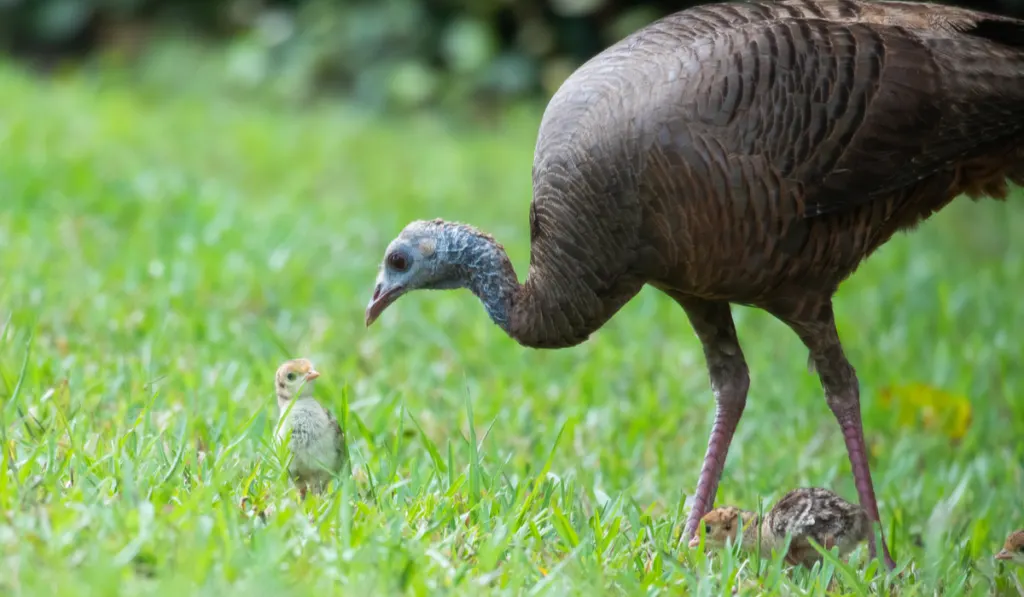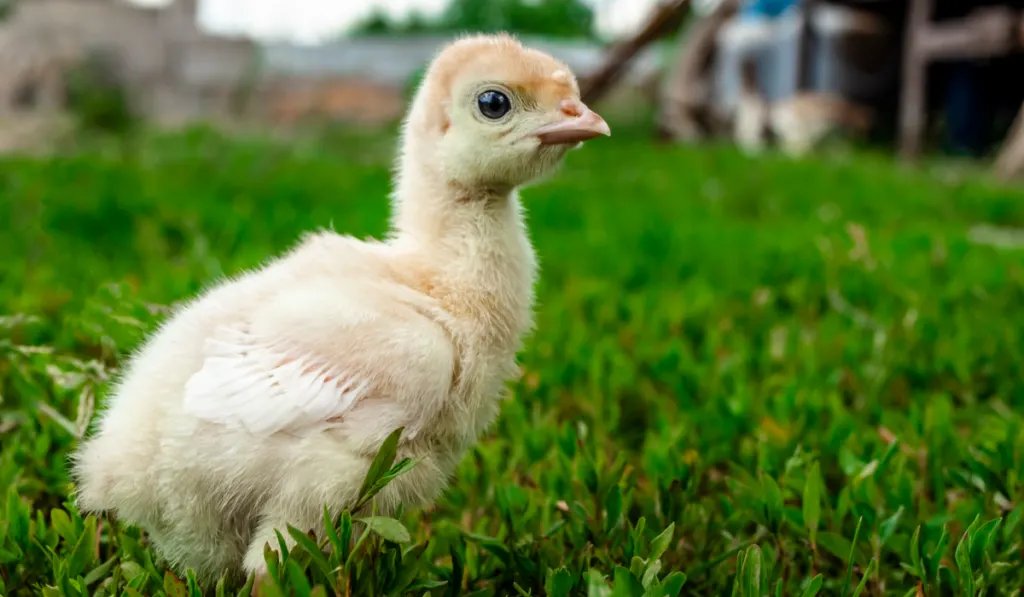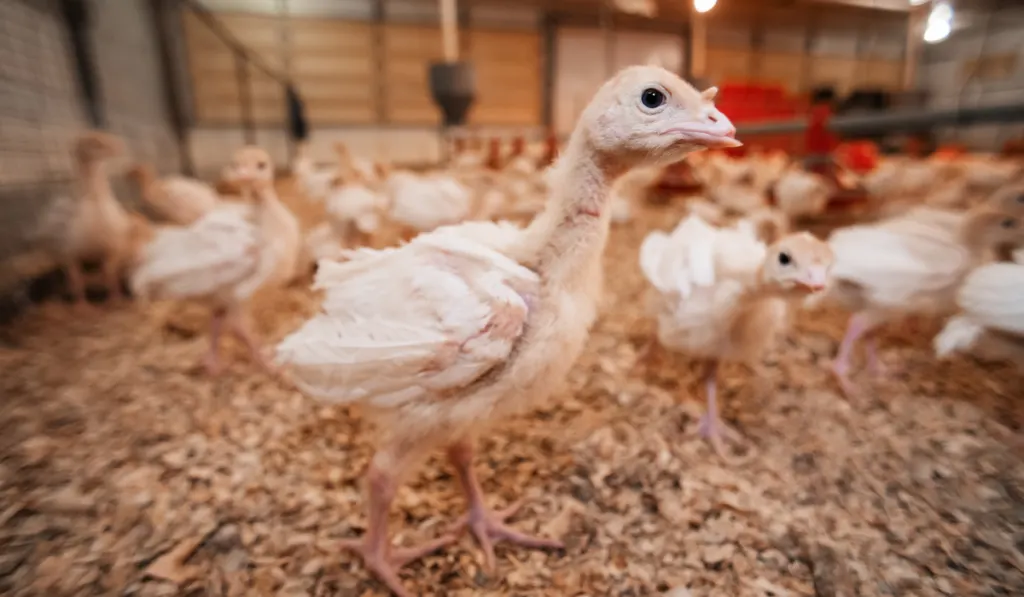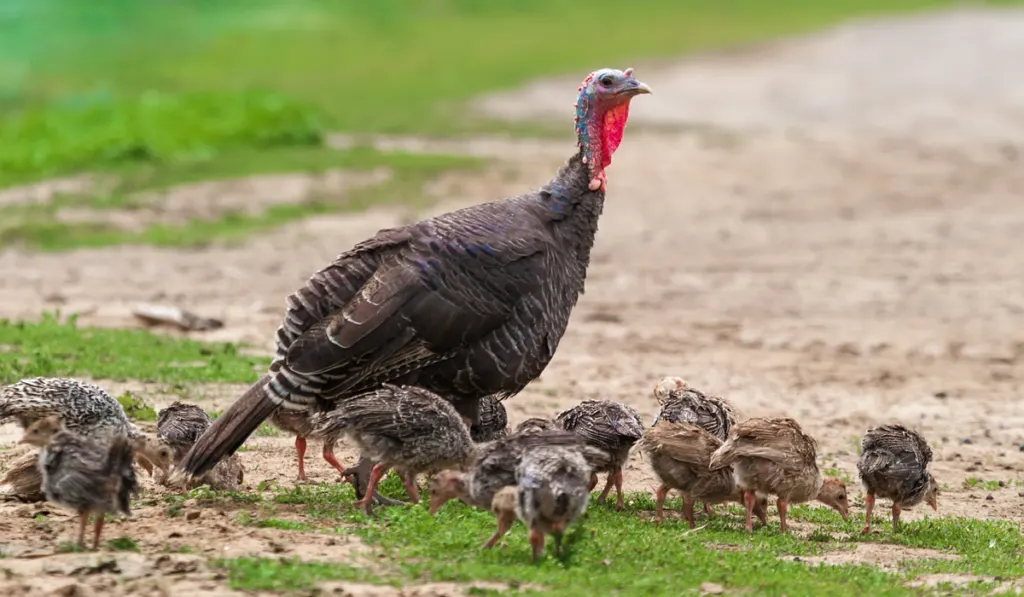Whether your hatching your own eggs or finding that perfect baby turkey name for your newly purchased chicks, everything about raising turkeys is fun. Brooding them in the house or garage is quite normal but, at some point they will need to move outdoors.
While you may want your baby turkeys to go outside as soon as possible, the last thing you’d want is for them to be outside prematurely. It’s important to evaluate your baby turkeys’ living environment before letting them go outside.
Baby turkeys can go outside on warm days when they are three weeks old, provided they are kept safe from predators. When baby turkeys are eight weeks old, they can go outside permanently, provided they are fully feathered, and the temperatures are not too low.

It’s important to note that when your baby turkey is ready to go outside depends on factors such as the condition of your baby turkey and the area you live in.
In this regard, it’s crucial to ensure that each individual baby turkeys’ needs are met before letting it go outside.
Table of Contents
Things to consider before letting your baby turkey go outside
Here are some things to take into consideration before letting your baby turkey go outside.
Baby turkeys feathers
When baby turkeys are three weeks old, they will not be fully feathered and therefore cannot spend extended periods outside. You can allow your baby turkeys to have access to an enclosed outdoor, sunny space to expose them to the outdoors once they are three weeks old.
However, they cannot spend time outside on cold days as they will not be able to regulate their own temperatures. Ensure that your baby turkey is fully feathered before leaving them outside for extended time periods.
Taking your baby turkeys on miniature outdoor adventures is a good way to introduce them to the outdoors slowly.
However, your baby turkeys should be supervised at all times and cannot remain outside all day until they are roughly six weeks old.
Temperature outside
Baby turkeys need to be gradually exposed to outside temperatures. You can gradually expose your baby turkeys by allowing them to go outside on warm days but keeping them inside on cold days and at night.

Once your baby turkeys are fully feathered, they can move outside if it’s not too cold. You can slowly introduce your baby turkeys to living outside by giving them access to the outdoors while still providing them with a radiant heat lamp for a night or two each week.
It’s important to be mindful not to overheat your baby turkeys in warmer weather. If your baby turkeys are being raised in a warmer climate with a draft-free living space, it might be unnecessary for them to have a heat lamp.
You can gauge whether your baby turkeys are too hot or too cold based on their behavior. If they are too hot, they will disperse and avoid any heat source.
Conversely, if they are too cold they will huddle up and crowd around the heat source. Ensure that there is sufficient space for your baby turkey to get away from the heat in case they are getting too hot.
Additionally, you’ll be able to tell if your baby turkeys are comfortable in their environment depending on the sounds they make. Baby turkeys are generally relatively quiet if they are happy and will cheep if they are ill or getting too cold.
Protection from predators
While you may be eager to take your baby turkey outside, the outdoors can be particularly risky as baby turkeys are vulnerable to predators and need to be adequately protected when going outdoors.
Cats are well-known predators when it comes to baby turkeys. Other predators include owls, hawks, snakes, skunks, weasels, raccoons, foxes, dogs, and opossums.
As a result of the high risk of predators, it is crucial that you ensure that if your baby turkeys are outside, they are sheltered in a manner that prevents predators from entering their space.
Making use of movable fences is a great way to allow your baby turkeys to free-range while protecting them from ground predators. If you elect to make use of an electric fence, ensure that the electricity used is only enough to stun an animal without killing it.
The last thing you need is dead predators because dead predators simply attract other predators, while a stunned predator is likely to be discouraged from bothering your baby turkeys.

Unfortunately, ground predators are not your only concern, as free-ranging baby turkeys are also susceptible to aerial predation from animals like owls and hawks. In this regard, you could eliminate any perch sites near the flock by removing perching surfaces like trees.
Alternatively, you could make use of a covered run to protect your baby turkeys from owls and hawks. Be sure to tightly secure any netting used as hawks can get through any weak, loose spots in the covering.
It is advisable that you use a run covered with welded wire to ensure that predators cannot fly in, nor dig under the fencing.
If you are experiencing issues with local predators and would like your flock to free-range, consider getting a guard dog.
Well-trained livestock guardian dogs can be highly effective in deterring predators. If the guard dog remains with the flock at all times, they will be able to deter predators both day and night.
In protecting your baby turkeys from predators, it’s important that you bear in mind that owls and hawks are federally protected species that you cannot trap, shoot or euthanize. Additionally, making use of noise and bird bombs is also prohibited in terms of federal laws.
Tips for maintaining baby turkeys
Here are some tips on how to look after baby turkeys.
Brooder conditions
Baby turkeys love heat. For the first week of your baby turkey’s life, their brooder temperature should be kept at 95-100 degrees.
In the weeks that follow, you should decrease the temperature by approximately 5 degrees were week until your baby turkeys are fully feathered. Your baby turkey should be fully feathered by the time they are eight weeks old.
Brooder size
Baby turkeys require adequate space to grow to full birds. The size of the brooder should be at least two square feet per bird.
However, it is ideal to allocate three to four square feet per baby turkey, to ensure that there is no overcrowding and each baby turkey can comfortably stretch their wings.

Water
Baby turkeys need a constant supply of fresh, clean water. The water served to baby turkeys should ideally be lukewarm, not too hot or too cold.
It is recommended that you use a poultry water dish, as open dishes can lead to the water getting dirty as your turkeys walk through it or leave droppings in it. There is also a risk of downing.
Using a specially designed water fountain is also a good way to prevent chicks from getting wet. Preventing your turkey chicks from getting wet means preventing them from feeling cold from the wetness after walking through their water.
However, if you must use an open water dish, ensure that you use a shallow water dish, and fill it with stones that are too large for your baby turkeys to ingest.
This will enable your turkey poults to drink from small pockets of water while minimizing the risk of drowning associated with large, deep water bowls.
Living environment
Baby turkeys require a draft-free living environment that offers proper ventilation as drafts and poor ventilation can result in unwanted health issues. Avoid placing your baby turkeys in cages with wire bottoms, as this could result in foot injuries.
Baby turkeys require a living environment that is clean and includes grass or soft bedding. Clean, dry bedding is most suitable, or you can use rubber drawer liners to create a non-slip surface.
Avoid using tiny shavings during your baby turkeys’ first few weeks of life, as these can be ingested. Furthermore, be cautious not to use cedar wood shavings as these could result in severe respiratory issues for your baby turkey.
Conclusion
The temperature of your area and whether your baby turkey is fully feathered are determining factors when considering whether your baby turkey can go outside.
Once you are confident that your baby turkeys are ready to go outside, it is important to safeguard them from predators when they are outside.
Resources
- https://www.treehugger.com/raise-turkeys-from-poults-3016806
- http://www.grangecoop.com/how-to-raise-baby-turkeys/
- https://www.backyardchickens.com/threads/baby-turkeys-are-cold.1301061/
- https://backyardpoultry.iamcountryside.com/poultry-101/a-guide-to-raising-turkey-poults/
- https://opensanctuary.org/article/special-care-recommendations-for-turkey-chicks/
